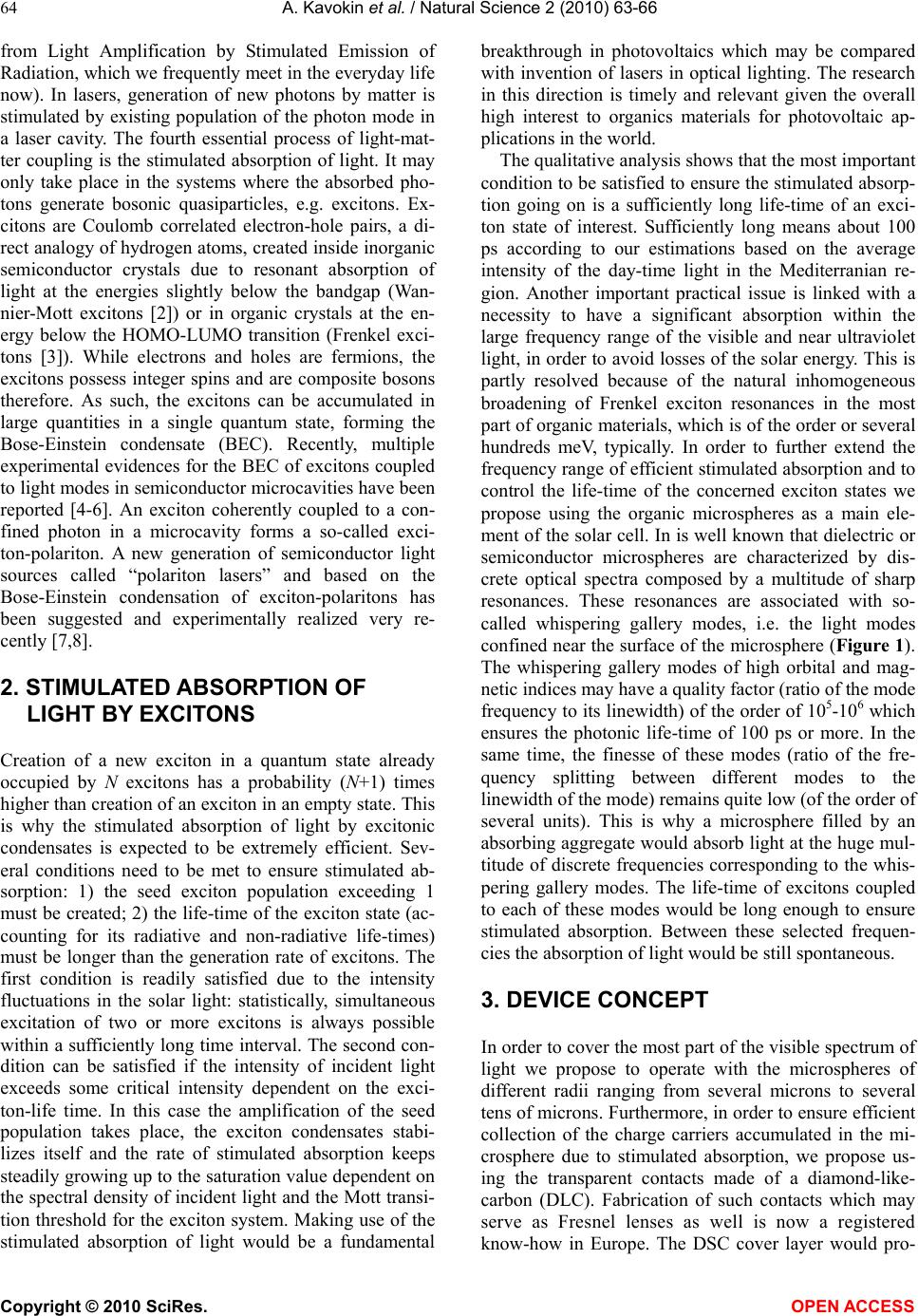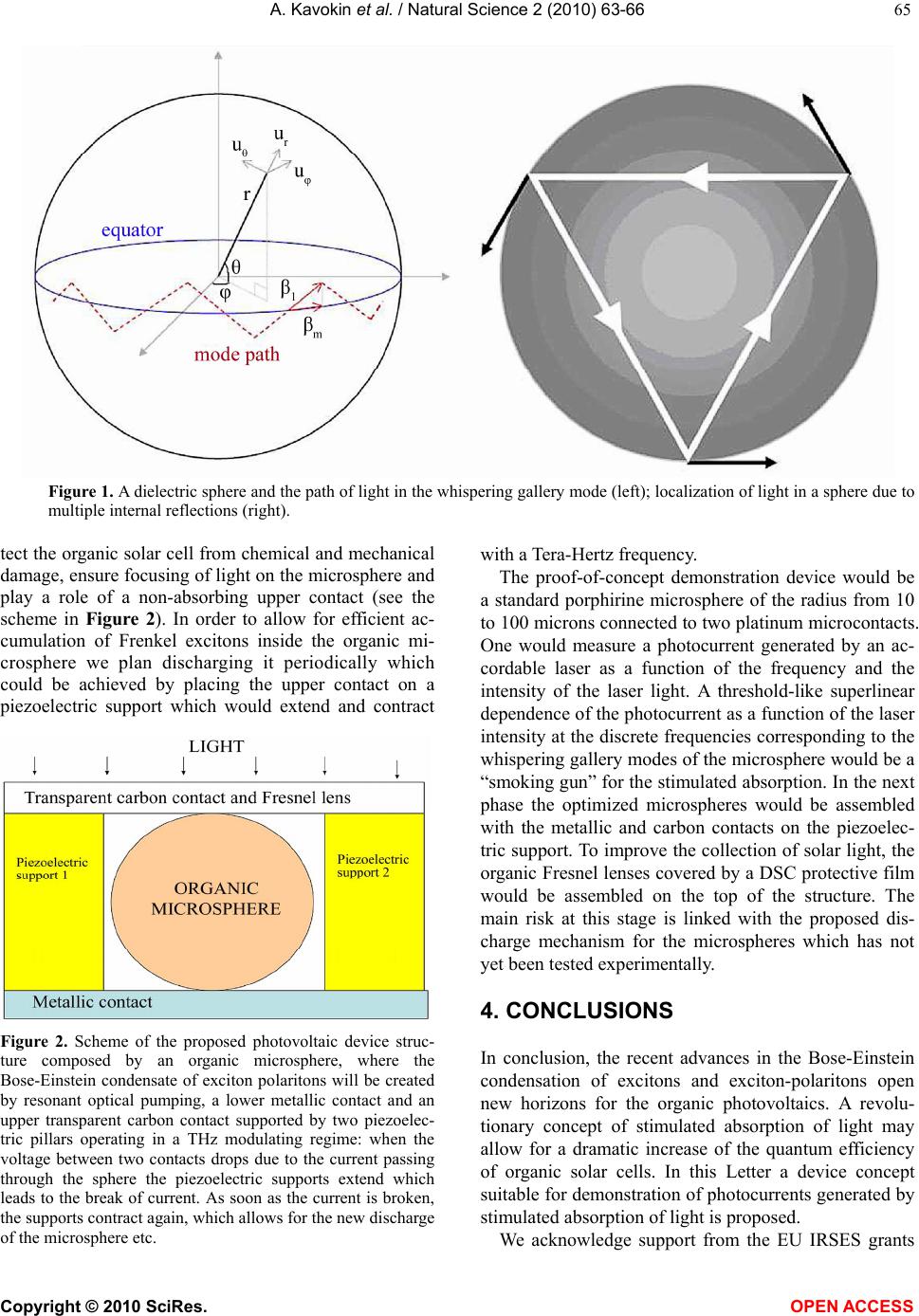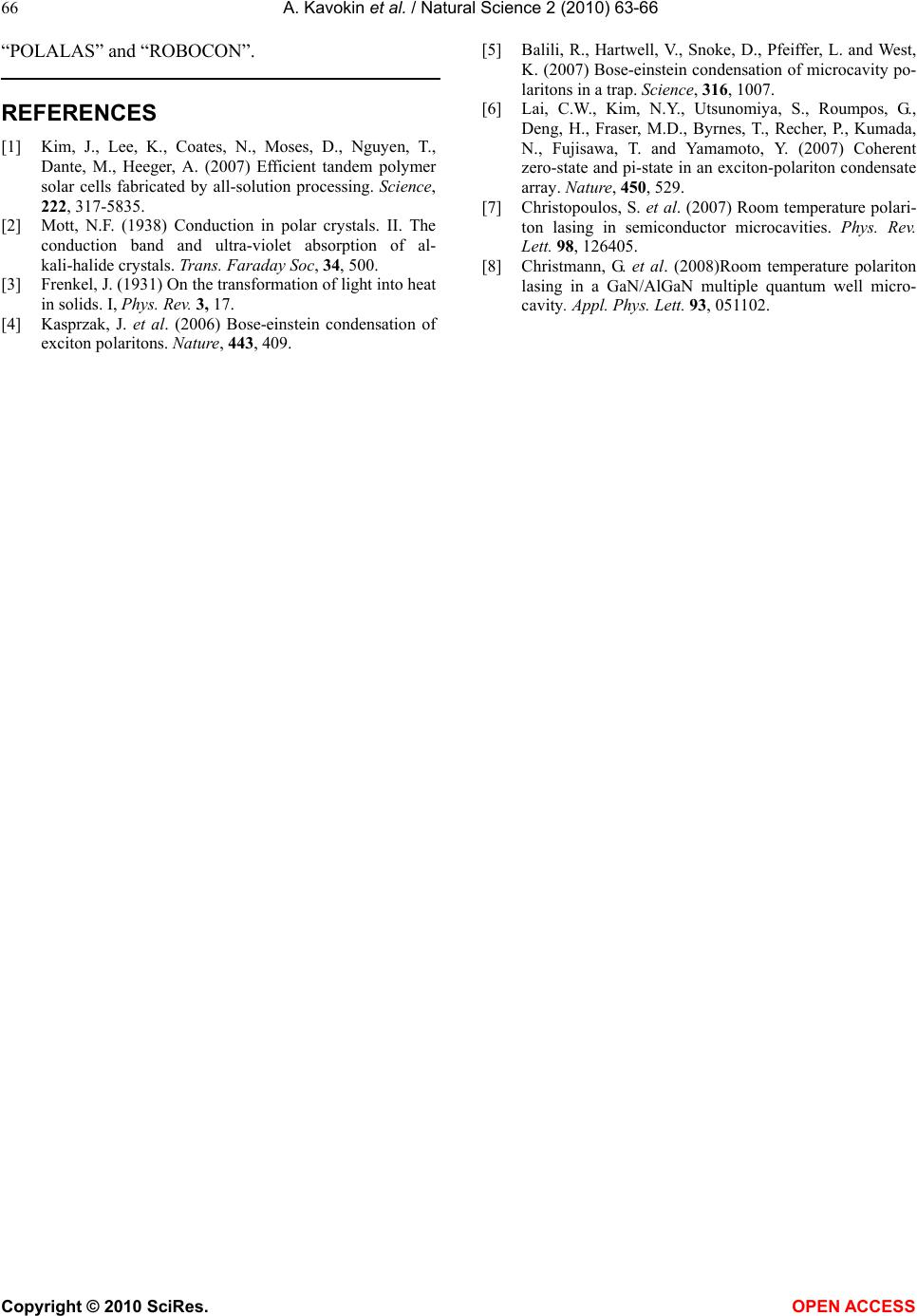Paper Menu >>
Journal Menu >>
 Vol.2, No.1, 63-66 (2010) Natural Science http://dx.doi.org/10.4236/ns.2010.21010 Copyright © 2010 SciRes. OPEN ACCESS Photocurrents induced by stimulated absorption of light Alexey Kavokin1, Giuseppe Eramo2 1Physics and Astronomy School, University of Southampton, Highfield, Southampton, United Kingdom 2Dipartimento di Fisica, Universita di Roma II, via della Ricerca Scientifica, Rome, Italy Received 23 October 2009; revised 13 November 2009; accepted 17 November 2009. ABSTRACT In organic materials absorption of light results in creation of the Frenkel excitons, Coulomb -bound electron-hole pairs having an integer spin. Being composite bosons, Frenkel excitons may accumulate in significant quantities in a single quantum state. The probability of photon absorption by such a state increases as (N+1) where N is the occupation number of the state. This enhancement is due to the stimulated ab- sorption of light, which is a final-state stimu- lated process analogous to the well-known stimulated emission of light. We propose using the stimulated absorption for creation of solar cells of a record quantum efficiency. We are going to use the organic microspheres to ac- cumulate the Frenkel excitons at the discrete frequencies corresponding to the photonic whispering gallery modes of the sphere. The dissociation of accumulated Frenkel excitons will be effectuated periodically using the trans- parent carbon contacts on a piezoelectric mechnical support. Keywords: SolarCell; Photovoltaics; Exciton; Bose-EinsteinCondensation 1. INTRODUCTION Development of the renewable sources of energy is a strategic economic priority nowadays. The solar energy is especially important for the tropical countries due to their favorable climate conditions. At present, the com- mercially available solar cells are based on silicon monocrystals which are relatively expensive and can hardly compete with the conventional energy sources therefore. Organic materials are widely discussed now as a valuable alternative to silicon but several obstacles still block the full-scale development of organic photovol- taics. First, unlike silicon, absorption of light in organics does not produce the free electron-hole pairs, but bound electrically neutral states known as Frenkel excitons. A significant external voltage needs to be applied to help dissociating the Frenkel excitons with formation of the unbound electrons and holes which contribute to the photocurrent [1]. Second, the metallic contacts used at present absorb light themselves which reduces signifi- cantly the quantum efficiency of photocells. The revolu- tionary improvement of the performance of the organic photocells due to the use of new materials and new physical effects is in the focus of this Letter. The starting idea is to take advantage of the bosonic properties of Frenkel excitons and use them to achieve the stimulated absorption of light. The photocells based on stimulated absorption are expected to posses a dramatically en- hanced quantum efficiency with respect to traditional photocells based on the spontaneous absorption of light. The expected difference is as huge as the difference be- tween a light emitting diode (producing light by sponta- neous emission) and a laser source (producing light by stimulated emission). Furthermore, we take advantage of the experience accumulated in the recent years in pro- duction of the optically transparent electric contacts based on the diamond-like-carbon (DLC) with embed- ded carbon nanotubes and to operate with the organic microspheres characterized by the photonic whispering gallery modes of extremely high quality factors. We emphasize the important role of photonic confinement in our photocells, which allows for resonant generation of macroscopic number of Frenkel excitons in the same quantum state during the life-time of the corresponding photonic mode. In turn, once being created, the macro- scopic population of Frenkel excitons reproduces itself by stimulated absorption of new solar photons. We pro- pose a new technology based on a new physics, new structures and new materials. The targeted outcome is a new generation of photocells with a drastically improved quantum efficiency. In 1917 Einstein has proposed the theory of radiation of atoms which accounted for three essential processes of light-matter interaction: the spontaneous emission of light, the spontaneous absorption of light by atoms and the stimulated emission of light. This latter process has found its use in the new coherent sources of light (lasers,  64 A. Kavokin et al. / Natural Science 2 (2010) 63-66 Copyright © 2010 SciRes. OPEN ACCESS from Light Amplification by Stimulated Emission of Radiation, which we frequently meet in the everyday life now). In lasers, generation of new photons by matter is stimulated by existing population of the photon mode in a laser cavity. The fourth essential process of light-mat- ter coupling is the stimulated absorption of light. It may only take place in the systems where the absorbed pho- tons generate bosonic quasiparticles, e.g. excitons. Ex- citons are Coulomb correlated electron-hole pairs, a di- rect analogy of hydrogen atoms, created inside inorganic semiconductor crystals due to resonant absorption of light at the energies slightly below the bandgap (Wan- nier-Mott excitons [2]) or in organic crystals at the en- ergy below the HOMO-LUMO transition (Frenkel exci- tons [3]). While electrons and holes are fermions, the excitons possess integer spins and are composite bosons therefore. As such, the excitons can be accumulated in large quantities in a single quantum state, forming the Bose-Einstein condensate (BEC). Recently, multiple experimental evidences for the BEC of excitons coupled to light modes in semiconductor microcavities have been reported [4-6]. An exciton coherently coupled to a con- fined photon in a microcavity forms a so-called exci- ton-polariton. A new generation of semiconductor light sources called “polariton lasers” and based on the Bose-Einstein condensation of exciton-polaritons has been suggested and experimentally realized very re- cently [7,8]. 2. STIMULATED ABSORPTION OF LIGHT BY EXCITONS Creation of a new exciton in a quantum state already occupied by N excitons has a probability (N+1) times higher than creation of an exciton in an empty state. This is why the stimulated absorption of light by excitonic condensates is expected to be extremely efficient. Sev- eral conditions need to be met to ensure stimulated ab- sorption: 1) the seed exciton population exceeding 1 must be created; 2) the life-time of the exciton state (ac- counting for its radiative and non-radiative life-times) must be longer than the generation rate of excitons. The first condition is readily satisfied due to the intensity fluctuations in the solar light: statistically, simultaneous excitation of two or more excitons is always possible within a sufficiently long time interval. The second con- dition can be satisfied if the intensity of incident light exceeds some critical intensity dependent on the exci- ton-life time. In this case the amplification of the seed population takes place, the exciton condensates stabi- lizes itself and the rate of stimulated absorption keeps steadily growing up to the saturation value dependent on the spectral density of incident light and the Mott transi- tion threshold for the exciton system. Making use of the stimulated absorption of light would be a fundamental breakthrough in photovoltaics which may be compared with invention of lasers in optical lighting. The research in this direction is timely and relevant given the overall high interest to organics materials for photovoltaic ap- plications in the world. The qualitative analysis shows that the most important condition to be satisfied to ensure the stimulated absorp- tion going on is a sufficiently long life-time of an exci- ton state of interest. Sufficiently long means about 100 ps according to our estimations based on the average intensity of the day-time light in the Mediterranian re- gion. Another important practical issue is linked with a necessity to have a significant absorption within the large frequency range of the visible and near ultraviolet light, in order to avoid losses of the solar energy. This is partly resolved because of the natural inhomogeneous broadening of Frenkel exciton resonances in the most part of organic materials, which is of the order or several hundreds meV, typically. In order to further extend the frequency range of efficient stimulated absorption and to control the life-time of the concerned exciton states we propose using the organic microspheres as a main ele- ment of the solar cell. In is well known that dielectric or semiconductor microspheres are characterized by dis- crete optical spectra composed by a multitude of sharp resonances. These resonances are associated with so- called whispering gallery modes, i.e. the light modes confined near the surface of the microsphere (Figure 1). The whispering gallery modes of high orbital and mag- netic indices may have a quality factor (ratio of the mode frequency to its linewidth) of the order of 105-106 which ensures the photonic life-time of 100 ps or more. In the same time, the finesse of these modes (ratio of the fre- quency splitting between different modes to the linewidth of the mode) remains quite low (of the order of several units). This is why a microsphere filled by an absorbing aggregate would absorb light at the huge mul- titude of discrete frequencies corresponding to the whis- pering gallery modes. The life-time of excitons coupled to each of these modes would be long enough to ensure stimulated absorption. Between these selected frequen- cies the absorption of light would be still spontaneous. 3. DEVICE CONCEPT In order to cover the most part of the visible spectrum of light we propose to operate with the microspheres of different radii ranging from several microns to several tens of microns. Furthermore, in order to ensure efficient collection of the charge carriers accumulated in the mi- crosphere due to stimulated absorption, we propose us- ing the transparent contacts made of a diamond-like- carbon (DLC). Fabrication of such contacts which may serve as Fresnel lenses as well is now a registered know-how in Europe. The DSC cover layer would pro-  A. Kavokin et al. / Natural Science 2 (2010) 63-66 Copyright © 2010 SciRes. OPEN ACCESS 65 Figure 1. A dielectric sphere and the path of light in the whispering gallery mode (left); localization of light in a sphere due to multiple internal reflections (right). tect the organic solar cell from chemical and mechanical damage, ensure focusing of light on the microsphere and play a role of a non-absorbing upper contact (see the scheme in Figure 2). In order to allow for efficient ac- cumulation of Frenkel excitons inside the organic mi- crosphere we plan discharging it periodically which could be achieved by placing the upper contact on a piezoelectric support which would extend and contract Figure 2. Scheme of the proposed photovoltaic device struc- ture composed by an organic microsphere, where the Bose-Einstein condensate of exciton polaritons will be created by resonant optical pumping, a lower metallic contact and an upper transparent carbon contact supported by two piezoelec- tric pillars operating in a THz modulating regime: when the voltage between two contacts drops due to the current passing through the sphere the piezoelectric supports extend which leads to the break of current. As soon as the current is broken, the supports contract again, which allows for the new discharge of the microsphere etc. with a Tera-Hertz frequency. The proof-of-concept demonstration device would be a standard porphirine microsphere of the radius from 10 to 100 microns connected to two platinum microcontacts. One would measure a photocurrent generated by an ac- cordable laser as a function of the frequency and the intensity of the laser light. A threshold-like superlinear dependence of the photocurrent as a function of the laser intensity at the discrete frequencies corresponding to the whispering gallery modes of the microsphere would be a “smoking gun” for the stimulated absorption. In the next phase the optimized microspheres would be assembled with the metallic and carbon contacts on the piezoelec- tric support. To improve the collection of solar light, the organic Fresnel lenses covered by a DSC protective film would be assembled on the top of the structure. The main risk at this stage is linked with the proposed dis- charge mechanism for the microspheres which has not yet been tested experimentally. 4. CONCLUSIONS In conclusion, the recent advances in the Bose-Einstein condensation of excitons and exciton-polaritons open new horizons for the organic photovoltaics. A revolu- tionary concept of stimulated absorption of light may allow for a dramatic increase of the quantum efficiency of organic solar cells. In this Letter a device concept suitable for demonstration of photocurrents generated by stimulated absorption of light is proposed. We acknowledge support from the EU IRSES grants  66 A. Kavokin et al. / Natural Science 2 (2010) 63-66 Copyright © 2010 SciRes. OPEN ACCESS “POLALAS” and “ROBOCON”. REFERENCES [1] Kim, J., Lee, K., Coates, N., Moses, D., Nguyen, T., Dante, M., Heeger, A. (2007) Efficient tandem polymer solar cells fabricated by all-solution processing. Science, 222, 317-5835. [2] Mott, N.F. (1938) Conduction in polar crystals. II. The conduction band and ultra-violet absorption of al- kali-halide crystals. Trans. Faraday Soc, 34, 500. [3] Frenkel, J. (1931) On the transformation of light into heat in solids. I, Phys. Rev. 3, 17. [4] Kasprzak, J. et al. (2006) Bose-einstein condensation of exciton polaritons. Nature, 443, 409. [5] Balili, R., Hartwell, V., Snoke, D., Pfeiffer, L. and West, K. (2007) Bose-einstein condensation of microcavity po- laritons in a trap. Science, 316, 1007. [6] Lai, C.W., Kim, N.Y., Utsunomiya, S., Roumpos, G., Deng, H., Fraser, M.D., Byrnes, T., Recher, P., Kumada, N., Fujisawa, T. and Yamamoto, Y. (2007) Coherent zero-state and pi-state in an exciton-polariton condensate array. Nature, 450, 529. [7] Christopoulos, S. et al. (2007) Room temperature polari- ton lasing in semiconductor microcavities. Phys. Rev. Lett. 98, 126405. [8] Christmann, G. et al. (2008)Room temperature polariton lasing in a GaN/AlGaN multiple quantum well micro- cavity. Appl. Phys. Lett. 93, 051102. |

